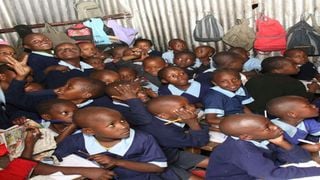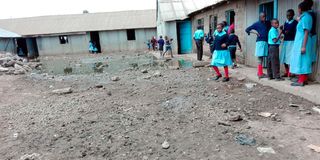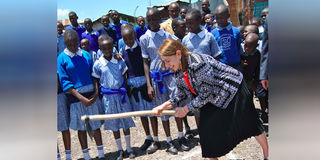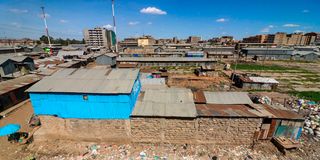
Pupils in an overcrowded class at Better Life Community School in Nairobi's Mukuru Kwa Reuben
| File | Nation Media GroupEducation
Premium
Scourge of private schools in Nairobi slums
In the heart of Mukuru Kwa Njenga slum, lies Kwa Njenga Primary School, a mere five-minute stroll away from a cluster of private schools. Nestled within this impoverished community, the public school stands as a beacon of hope for the numerous children who yearn for educational opportunities with an unquenchable thirst.
Mukuru Kwa Njenga is just one piece of the vast puzzle that makes Mukuru slums. This sprawling urban area is home to countless families struggling to make ends meet as they grapple with the harsh realities of poverty.
In Aviation Village in Embakasi Brevilly Adongo, 13 almost failed to join Form One despite having scored 333 marks in the Kenya Certificate of Primary Education (KCPE) examinations. He did not qualify for a government scholarship despite his family’s poor economic standards since he attended a private school, Jubilant Junior School.
He had been ‘sponsored’ by the school administration owing to his good performance, a trend the Nation established is common in private schools in the slums but which later comes to haunt the learners once they have played their part in boosting the mean score of the school.
Most of the children in the area attend private schools since there are no public institutions, a problem noted especially in many estates established in recent years. Many of the public institutions in Nairobi County are the ‘City Council’ schools established in the 1970s, 1980s, 1990s and a few after 2000.

Tina’s Education Centre in Nairobi’s Mukuru Kwa Reube on July 19, 2017.
Two years ago, Vanessa Wanjiru also missed out on government scholarship despite scoring 402 marks and getting admission to Mary Hill Girls High School. She had attended a private school in Dandora under the sponsorship of the proprietor. She was lucky to get a scholarship from the Middle East Bank.
The rise of unregistered schools preying on lack of alternatives is fuelled by desperate parents. The schools operate outside the purview of government oversight, escape regulatory checks and balances, thereby compromising the quality of education provided.
Furthermore, the absence of accountability mechanisms allows the institutions to employ untrained teachers who lack the necessary qualifications and pedagogical skills, further jeopardizing the student’s educational development.
In a quest to comprehend the functioning of the education system, we venture into Mukuru Kwa Njenga, Mukuru Kwa Reuben, Mathare, and Kawangware armed with our Kenya Certificate of Secondary Education and KCPE results slips, seeking teaching positions.
Surprisingly, all the schools we visited share a common requirement – proof we had completed secondary school. Unfortunately there were no vacancies so we left our applications there.
“We are not employing new teachers. However, you can leave your documents; we will contact you,” said an official at a school in Mukuru Kwa Reuben, an iron-sheet structure squeezed between rental houses that does not have a playing ground. The enrolment is barely 100.
According to Risper Kigen, a social worker in the area, private schools face challenges that, in turn, pose safety concerns for the children. Initially, there was only one public school in the sprawling slum but now there are two.
Given the high population density, many parents are compelled to enrol their children in alternative institutions, particularly during their early years.
As of 2021, Kenya counted 32,594 primary educational institutions, including private and public schools. The amount increased from 31,464 in 2020 when a peak was reached. However, according to Nairobi City County Education Department data, the county has 225 public primary schools and hundreds of private primary schools.
The proliferation of private learning institutions in low-income settlements can be attributed to the longstanding problems of an underfunded public education system.
Insufficient investment in infrastructure, resources and qualified teachers has resulted in congested classrooms, scramble for facilities and poor learning outcomes. As a result, parents turn to private outfits, regardless of their legitimacy.

President and CEO of US Africa Development Shari Berenbach (left) during the groundbreaking ceremony for the biogas project at Mkuru kwa Njenga Primary School, an initiative of Solar World and US Africa Development Foundation February 28, 2014
“I have two children, both are under five years old. I’d rather take them to private schools where I pay Sh3,000 and they have a good foundation rather than taking them to the public schools,” said one parent from Kawangware, 46.
The Nation established that negative perceptions of public primary schools have played a part in luring parents to private entities.
From all the schools we visited in different areas, all reported that they have untrained teachers or those who are seeking qualifications. Trained teachers are shunned since their salaries are higher and they are constantly on the lookout for better opportunities elsewhere.
“Hiring trained teachers ask for Sh25,000 (per month), so we just hire students who have dropped out from campus or some who have completed but still not accredited or the ones who are unemployed and pay them Sh15,000,” said Esther Kadenge, director at Mosester Academy.
In the recent National Budget estimates presented in Parliament by Treasury CS Njuguna Ndungu, the Ministry of Education got the lion’s share of the Sh3.68 trillion budget for 2023-24 financial year. The ministry was allocated Sh628.6 billion, equivalent to 27.4 per cent of the entire budget.
This is a Sh84.2 billion increase from the Sh544.4 billion former President Uhuru Kenyatta allocated the docket in for the 2022-23 financial year.
President William Ruto a week ago, acknowledged the shortage of public primary schools in the capital city, a situation he described as ‘tragic’. This was during the launch of the Nairobi County schools feeding programme. He said that the government aims to construct 6,000 more classrooms, with target of putting up 3,500 new classrooms in three years at a cost of Sh3 billion to ease congestion in public primary schools.
“Nairobi has the least number of schools; as a percentage of the population of Nairobi, we have the least schools than any other county in Kenya. We have 204 schools, with 17 constituencies. It’s tragic. Many children don’t go to school while many others go to shabby schools because there’s no alternative,” Dr Ruto said.
He called upon Education cabinet secretary Ezekiel Machogu and Nairobi members of Parliament to agree on how to build more schools in the city.

A section of Nairobi's Mukuru Kwa Njenga slum on June 8, 2023.
“We need to build an extra six thousand classrooms because we need to double the enrolment of children in Nairobi County. There are no opportunities for them to learn in a proper school,” Dr Ruto said.
The President said that members of the Nairobi County Assembly had also committed to build 1,500 classrooms in their wards over the next three years.
Nairobi governor Johnson Sakaja said that he is in consultation with Mr Machogu on how to put up more schools in the county.
“We’ve wronged the children of Nairobi. We have 210 schools only for a population of five million people. Our children who are not in private schools aren’t in expensive academies. They are in Alternative Provision of Basic Education and Training institutions. Successive governments have done bad to the children of Nairobi,” Mr Sakaja said.
Dr Ruto instructed Mr Machogu to facilitate the construction of 30 new classrooms at Roysambu Primary School within four months. He said the project will cost Sh25 million.
The President was responding to a request by the headteacher of the school who said that the classrooms are congested with an average of 110 learners in a classroom against the recommended 40. The school has an enrolment of 3,400 learners.






